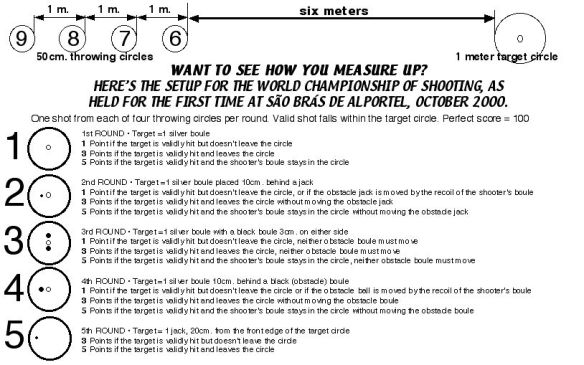Here is a great post from the Harrogate Montpellier Petanque Club. I’ve lightly edited it for American readers.
First boule of the end

Always try to put your first boule in front of the jack. About 30-50 cm is a good distance, but even a meter in front is better than 10cm behind (see Backstops below). The French have a saying, “Une boule devant, c’est une boule d’argent” – A boule in front, that’s a money boule.
The ‘boule devant’ has two advantages:
- your opponent cannot roll their boule directly to the jack but must aim to the side of your boule.
- If their aim is a little off (or they get a deflection from an uneven terrain) and they hit your boule, the chances are that they’ll push your boule closer to the jack.
Backstops
 A boule just behind the jack is a gift to the pointer.
A boule just behind the jack is a gift to the pointer.
It’s much easier to stop a boule against a backstop than it is to stop it without. Just throw slightly harder than you think you need to and let the backstop do its job. A boule resting against a backstop is also harder to knock away. If it is shot, it will be knocked backward; it will hit the backstop boule; all of the momentum will be transferred to the backstop boule (which will go flying!) and the boule that was struck will stay nearly in its original place.
Of course, there’s nothing to stop the opposition from now using your boule as a backstop — but that’s all part of the game.
Promoting your boules
 As mentioned above, boules in front of the jack can be promoted by running your boule into them and knocking them forward. [Americans usually call this “pushing” your own boule.] There’s often an additional benefit in that the second ball remains close to the point of impact, forming a blocker.
As mentioned above, boules in front of the jack can be promoted by running your boule into them and knocking them forward. [Americans usually call this “pushing” your own boule.] There’s often an additional benefit in that the second ball remains close to the point of impact, forming a blocker.
Be careful if there’s an opposition boule close to the one you wish to promote. You can push an opponent’s boule as easily as one of your own, so take into account how accurately you can throw.
Limiting the damage
A common scenario for beginners starts when the opposition get a boule very close to the jack early in the end. You can’t really point closer so you try to shoot it away. Your team’s throws keep getting closer and you’re sure the next one will do it but you suddenly realize that your team have used up all of your boules! Your missed shots have probably all gone sailing off well past the jack, allowing the opposition to rack up a big score with their remaining boules.
To reduce the odds of getting thrashed like this, you need to point one or two boules that, although not closest to the jack, are close enough to make it difficult for the opposition to score lots of points. Better for them to score a couple of points than five or six.
Ideally, try to make your boule snuggle up to the opposition’s closest boule so that they’ll think twice about trying to shoot yours away.
When limiting the damage won’t work
Of course in a situation where the opposition team needs only a single point to win the game, limiting the damage to only one point won’t help. Strategies to consider in this situation are:
- Shoot the jack out of bounds, but only if they have thrown all of their boules. This is a skillful shot but it stops the opposition scoring.
- Point slightly hard towards the jack and try to knock it towards some of your boules.
- Point and hope to beat the opposition boule.
- Shoot the opposition boule and hope that that will leave you closest.
None of these strategies are an easy option but you don’t have a lot of choice.
















